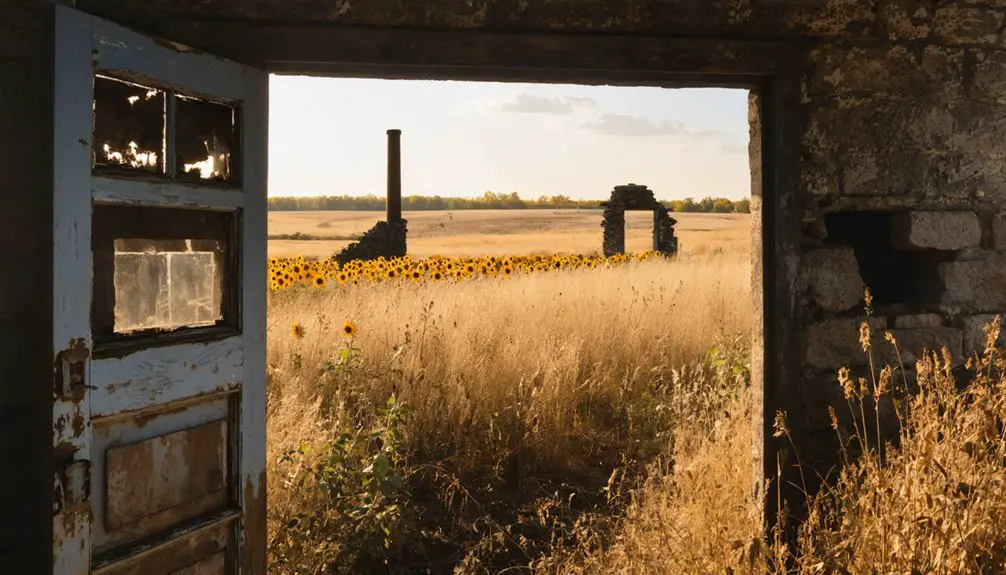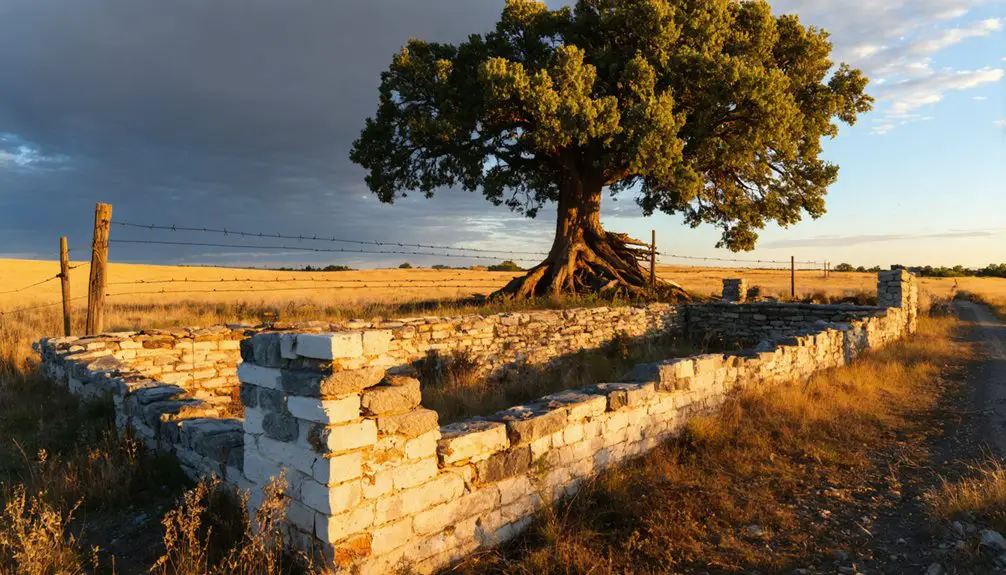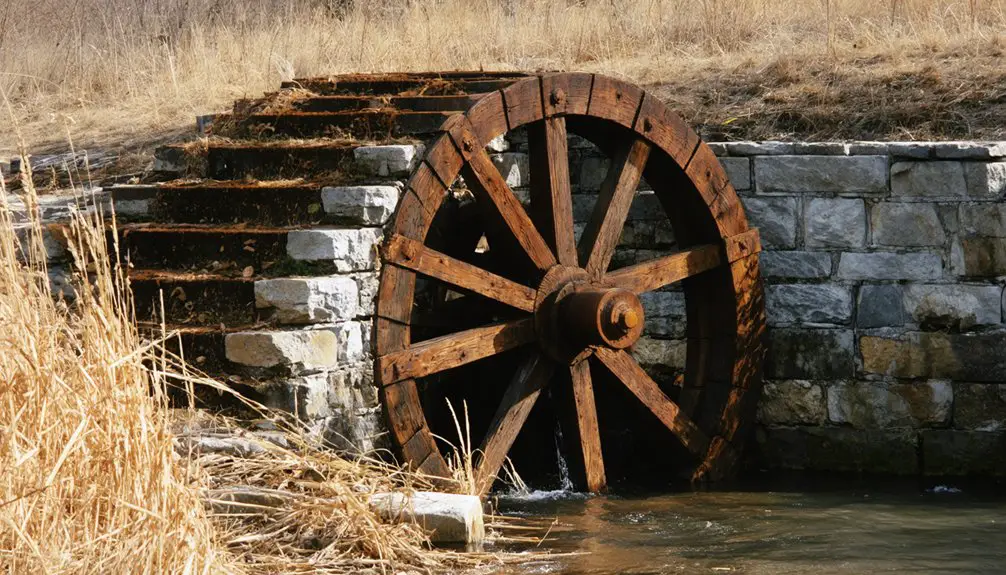You’ll find Agnes City’s ghost town remnants near Council Grove, Kansas, where Arthur Baker established this Santa Fe Trail trading post in 1856. The settlement thrived briefly with a store, blacksmith shop, and mill until Baker’s murder in 1862 sparked its decline. Today, only two markers remain: a granite Santa Fe Trail monument and a small cemetery containing Baker family graves. The site’s dramatic story reveals the volatile nature of Kansas Territory settlements.
Key Takeaways
- Agnes City was established in 1856 by Arthur Baker near Council Grove, Kansas, serving as a trading post along the Santa Fe Trail.
- The town featured essential frontier infrastructure including a store, blacksmith shop, mill, post office, and Baker’s family residence.
- After Arthur Baker’s murder in 1862 and the burning of his store, the town experienced rapid decline.
- The settlement completely disappeared, leaving only two remnants: a granite Santa Fe Trail marker and a small cemetery.
- The ghost town site is now agricultural land, though it represents an important chapter in Kansas territorial history.
The Birth of a Frontier Settlement
As Kansas Territory approached statehood in 1856, Arthur Inghram Baker established Agnes City, a frontier settlement situated eight miles east of Council Grove along Rock Creek.
Baker, who’d previously worked with the Sac and Fox Indian Agency in Iowa, recognized the location’s strategic value near the Santa Fe Trail for addressing frontier challenges and supporting early commerce.
You’ll find Baker wasted no time developing the settlement’s infrastructure. He built his home, opened a store to supply travelers and freighters, constructed a blacksmith shop, and established a mill.
As the town’s founder, he also secured a post office and became Justice of the Peace. Named after Baker’s mother Agnes, the settlement was incorporated in 1857 as a family-owned enterprise with his brothers-in-law joining the venture.
While the town was incorporated, it was unique in that it was never platted into lots for typical town development. The settlement prospered under Baker’s leadership until his life was tragically cut short by Bloody Bill Anderson.
Life Along the Santa Fe Trail
While Agnes City thrived near the Santa Fe Trail, this essential commercial artery bustled with traders hauling manufactured goods westward to Santa Fe and returning with precious metals, furs, and livestock.
Trail commerce flourished, with early caravans bringing back substantial wealth – one 1824 expedition returned with $180,000 in gold and silver plus $10,000 in furs. Manuel Escudero helped negotiate border openings for Mexican traders in 1825, expanding commercial opportunities. A treacherous sixty-mile desert between Arkansas River and Cimarron Spring posed significant challenges for travelers.
Merchants struck it rich on the Santa Fe Trail, with a single 1824 caravan hauling $190,000 in precious goods eastward.
You’d encounter these key features of trail life:
- Military escorts protecting wagon trains from Fort Leavenworth to the Mexican border
- Trading posts and forts like Bent’s Fort supporting logistics
- Comanche tribes demanding payment for passage through their territories
- Famous landmarks like Pawnee Rock guiding travelers westward
Cultural exchange thrived at trail towns like Council Grove and Great Bend, where merchants, soldiers, and Native Americans intersected in this dynamic frontier economy.
The Baker Family Legacy
The Baker family’s imprint on Agnes City began when Arthur Inghram Baker founded the settlement in 1856, naming it after his mother Agnes, who worked at the Kaw Indian Mission in Council Grove.
The Baker heritage ran deep, with Arthur establishing vital town infrastructure including a trading post, mill, and store while serving as postmaster.
Archaeological excavations in 1972 uncovered Baker’s home foundation near Rock Creek, providing tangible evidence of the family’s presence.
You’ll find evidence of the family’s resilience in how they incorporated the town with Baker’s brothers-in-law and maintained strong ties through the Secor family connection.
Following escalating tensions with the Anderson family over horse thefts and rivalries, Bill Anderson and his gang attacked the settlement in 1862.
Tragedy struck when Arthur’s wife Annis survived a violent attack on the town, only to later drown with her second husband while crossing the Neosho River.
Today, the family’s legacy lives on through the township name and burial grounds near the original townsite.
Tragedy Strikes Agnes City
Violent tragedy shattered Agnes City’s promising future in 1862 when members of the Anderson family lured Arthur Baker into his store’s cellar and murdered him. The attackers then set the store ablaze, marking the beginning of the town’s decline.
Despite this blow to community resilience, some families remained, with two more postmasters serving after Baker’s death. Today, only the Santa Fe Trail marker stands as a testament to the town’s existence. Like many Kansas ghost towns, Agnes City now lies hidden beneath plowed fields of grain.
Agnes City showed glimmers of endurance after Baker’s murder, as evidenced by two subsequent postmasters continuing mail service.
The emotional legacy of violence was compounded by nature’s fury in 1872 when:
- Baker’s widow Annis and her new husband J.B. Somers drowned in the Neosho River
- Two others perished with them in the sudden flood
- The town’s infrastructure continued deteriorating without repair
- Residents steadily abandoned Agnes City for safer communities
These consecutive tragedies ultimately sealed the town’s fate, transforming it into the ghost town you’ll find today.
The Town’s Gradual Decline
Following Arthur Baker’s murder in 1862, Agnes City experienced an accelerating downward spiral marked by the post office’s closure in 1866 and steady population loss.
The burning of Baker’s store devastated the local economy, while railroad development bypassed the settlement, leading to economic stagnation.
You’ll find that social instability plagued the remaining residents, who faced ongoing threats from floods, disease outbreaks, and harsh prairie conditions.
Living in basic cabins without amenities, families struggled with isolation and limited resources. Like the residents of mining town Mindenmines, the population steadily declined as economic opportunities vanished.
The drowning of Mrs. Annis Baker and others in 1872 dealt another devastating blow to the community.
While some settlers tried to maintain the town after 1866, the combination of environmental challenges, declining Santa Fe Trail traffic, and lack of commercial opportunities ultimately sealed Agnes City’s fate.
What Remains Today
Only two physical remnants mark Agnes City‘s former existence today: a granite Santa Fe Trail marker installed by Kansas DAR members in 1906 and a small cemetery located near Bushong in Lyon County.
You’ll find both sites near the intersection of Road 360 and Road E, about eight miles east of Council Grove.
- The marker’s significance lies in commemorating Agnes City’s role as a crucial Santa Fe Trail trading post.
- The cemetery preserves graves of early settlers, including connections to founder Arthur Baker’s family.
- No original buildings or infrastructure remain visible at the town site.
- The area has returned to rural agricultural land, with minimal modern development.
Unlike nearby Council Grove with its preserved historic structures, Agnes City’s legacy survives solely through these two silent sentinels of Kansas territorial history. Much like St. Elmo’s unpaved access road, visitors must navigate dirt roads to reach these remote historical markers.
Historical Impact on Kansas Territory

Agnes City’s establishment in 1856 represents a critical moment in Kansas Territory’s development when settlers were pushing into lands previously inhabited by Kaw and other Native American tribes.
You’ll find that Agnes City’s story mirrors the broader territorial conflicts, as its sudden decline following Baker’s murder in 1862 exemplifies how violence shaped settlement patterns throughout Kansas.
The town’s location along the Santa Fe Trail and its eventual abandonment demonstrate how frontier settlements often thrived or failed based on their ability to navigate both commercial opportunities and mounting tensions between various territorial factions.
Settlement During Indian Migrations
During the mid-19th century, the complex interplay between Native American migrations and early settler movements shaped the establishment of Agnes City, Kansas.
Arthur Inghram Baker, understanding the strategic value of Indigenous trade routes, chose a location near the Marias Des Cygne River and Rock Creek that served both settler and Native American interests.
- The settlement’s position along the Santa Fe Trail created a natural trading hub where settlers and indigenous peoples exchanged goods.
- Baker’s ties to the Sac and Fox Indians influenced his choice of location, maximizing trade opportunities.
- Migration patterns of the Kaw and other tribes determined the flow of commerce through Agnes City.
- The town’s infrastructure, including Baker’s blacksmith shop and store, developed to serve both settler and Native American communities.
Violence Shapes Territory Development
The volatile period known as “Bleeding Kansas” transformed Agnes City and the surrounding territory between 1854-1859, as pro-slavery and anti-slavery factions waged a brutal guerrilla war that claimed up to 200 lives.
You’ll find that territorial conflicts dominated daily life, with rival governments competing for control while armed militias conducted raids and retaliatory attacks.
Violent rivalries between Missouri “border ruffians” and free-state settlers created an atmosphere of terror, disrupting settlement patterns and economic development.
Electoral fraud and land disputes further intensified the fighting, as both sides sought to influence Kansas’s future through force.
The region’s resources were diverted from constructive development to defense, as competing armed enclaves emerged and personal attacks became commonplace.
Frequently Asked Questions
What Role Did Native American Tribes Play in Daily Life at Agnes City?
You’ll find Native American influence shaped daily trade, blacksmithing, and cultural exchange at Rock Creek trading post, while tensions and violence between settlers and tribes created an undercurrent of conflict and unease.
How Many Buildings Were Actually Constructed During Agnes City’s Peak Existence?
Like a sparse frontier outpost, you’d find only four main buildings at its peak: Baker’s home, a bustling mill, a blacksmith shop, and a trading store serving travelers.
What Goods and Services Were Traded at Baker’s Store?
You’d find traded goods like trail supplies, flour, sugar, tools, and Native American trade items, plus local services including mail delivery, lodging, repairs, and justice of the peace duties.
Did Any Famous Santa Fe Trail Travelers Document Their Stops at Agnes City?
Like a needle in history’s haystack, you won’t find famous Santa Fe travelers’ direct documentation of Agnes City stops, though heavy trail traffic nearby at Elm Creek suggests many passed through.
Were There Any Attempts to Revive the Original Agnes City After 1866?
You won’t find records of any organized revival efforts after 1866. While some families stayed near the original site, no one attempted to formally reestablish the town’s historical significance as a settlement.
References
- https://legendsofkansas.com/agnes-city-kansas/
- https://dianastaresinicdeane.wordpress.com/tag/agnes-city/
- https://fromthebarberschair.wordpress.com/2013/04/02/agnes-city/
- https://sites.rootsweb.com/~ksfhgslc/agnescem.html
- https://freepages.rootsweb.com/~gtusa/history/usa/ks.htm
- https://www.legendsofamerica.com/ks-santafetraillyco/
- https://mountmitchellprairie.org/kansas-heritage-history-mount-mitchell/
- https://flatlandkc.org/history/recalling-kansas-citys-gilded-age/
- https://en.wikipedia.org/wiki/Santa_Fe_Trail
- https://www.kspatriot.org/index.php/articles/35-kansas-trails/76-brief-history-of-the-famous-santa-fe-trail.html



